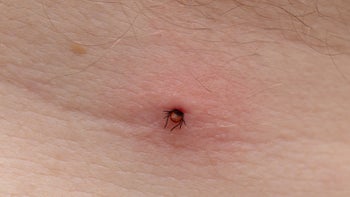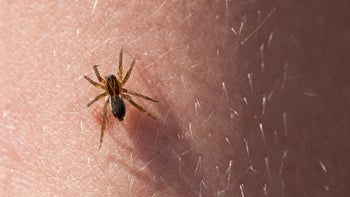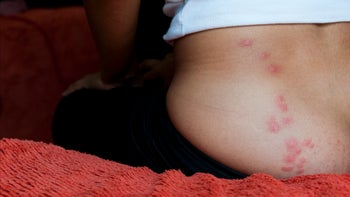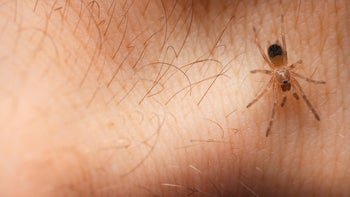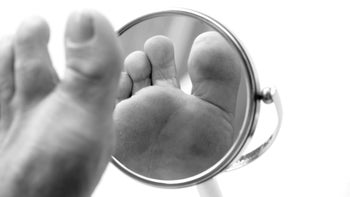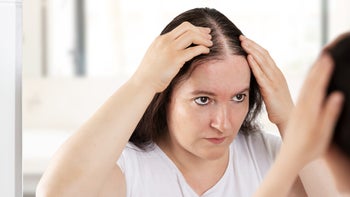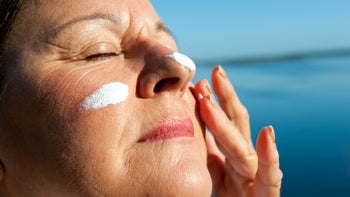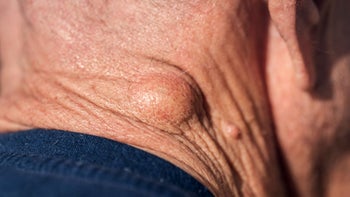
Cracked, Painful Lips Could Be Angular Cheilitis — Here’s How to Treat It
Key takeaways:
Angular cheilitis is a skin condition that causes painful cracks at one or both corners of the lips. People who wear dentures have a higher risk of developing this condition.
Treatment for angular cheilitis uses a combination of antibiotic, antifungal, and steroid creams.
Even though bacteria and fungi can cause angular cheilitis, the condition isn’t contagious.

From time to time, everyone gets dry, cracked lips. Sometimes a little lip balm is all you need to get back to normal. But other times, getting your lips back to their usual, pain-free state can be more challenging.
If you’ve been dealing with cracked lips that just won’t heal, you might have angular cheilitis. Here’s what you should know about this painful lip condition and how to get rid of it for good.
What is angular cheilitis?
Angular cheilitis is a skin condition that affects the corners of the mouth, where the top and bottom lip meet. It leads to painful inflammation, cracking, and sores at one or both corners of the mouth.
Angular cheilitis usually starts when saliva pools at the corners of the mouth. This leads to skin irritation and cracking. Bacteria and fungi that normally live on the skin can then get into the cracks. This can worsen the inflammation and cause a skin infection.
Could you have a cold sore? Learn all about cold sores, including symptoms and how to get rid of them.
Medications can cause mouth symptoms. From black hairy tongue to burning mouth syndrome, see what medications are most likely to cause mouth symptoms.
Have dry or chapped lips? Here are some common causes of chapped lips and what you can do about them.
What are the symptoms of angular cheilitis?
Angular cheilitis is usually pretty easy to spot. You might notice the following symptoms at one or both corners of your mouth where your top and bottom lip meet:
Redness
Pain
Cracks or openings (fissures)
A burning sensation when you touch the area
Swelling
Scabbing
Light bleeding
Here are some images showing what angular cheilitis looks like. Without treatment, angular cheilitis can get worse and spread beyond the corners of the mouth.
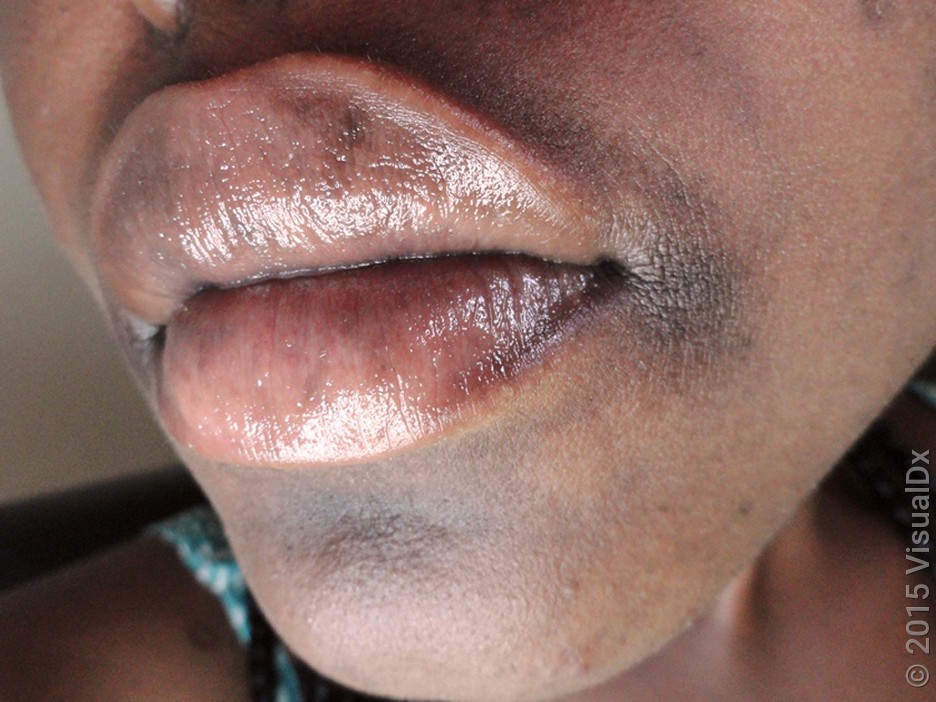

What's the difference between angular cheilitis and a cold sore?
Cold sores are caused by viruses. They can develop on the corners of the mouth but more commonly happen on the lips. They form painful bumps and blisters and eventually scab over. Cold sores don’t cause cracks or fissures the way angular cheilitis does.
Here’s another important difference: The virus that causes cold sores is contagious. That means a person with a cold sore can pass the virus to someone else. Angular cheilitis isn’t contagious. So, you don’t have to worry about spreading it to others.
Who is most at risk for developing angular cheilitis?
Anyone can develop angular cheilitis. But some people are at higher risk than others. This is usually because they have a condition that can irritate the skin or cause saliva to pool at the corners of the mouth. You may be at higher risk if you:
Wear dentures: People who wear dentures are three times more likely to develop angular cheilitis. Dentures increase the risk of saliva pooling at the corners of the mouth. Plus, dentures wearers are more likely to be older and have lax skin.
Wear braces: Some braces are made with nickel, which can irritate the skin. People with braces may have teeth that don’t line up when they close their mouth (called malocclusion). This can cause extra tension on the corner of the mouth and lead to saliva pooling there.
Chew a lot of gum: Extra saliva caused by gum-chewing can irritate the corners of the mouth and lead to angular cheilitis.
Lick your lips: Frequent lip-licking can bring saliva in direct contact with the corners of the mouth. Thumb-sucking also raises the risk of angular cheilitis for the same reason.
Wear a mask: A mask can directly irritate the skin around the lips. It can also trap saliva against the mouth. Children who use pacifiers can also develop angular cheilitis for the same reason.
Search and compare options
Certain medical conditions can also increase your risk of having angular cheilitis. For example:
Autoimmune conditions, like inflammatory bowel disease and Sjögren’s syndrome
Medical conditions that weaken the immune system
Medical conditions that require you to take medications that weaken the immune system (like steroids)
Chronic skin conditions, like eczema or allergic contact dermatitis
Diagnosing angular cheilitis
Your dermatologist or another healthcare professional can usually diagnose angular cheilitis just by examining your mouth. They may also ask you some questions about your medical history, the medications you take, and other risk factors. In some situations, you may need a swab to check for a fungal or herpes infection.
Treatment for angular cheilitis
Most people need a combination of treatments to get rid of angular cheilitis. Self-care along with prescription medications can help heal cheilitis. Your treatment plan may include one or several of these options.
Angular cheilitis self-care
Cold compresses can help reduce pain and swelling caused by angular cheilitis. You can either use an ice pack or ice cubes wrapped in a clean towel.
It’s also a good idea to avoid skin irritants, like mouthwash or harsh soaps and creams.
Read more like this
Explore these related articles, suggested for readers like you.
Petrolatum ointment
Petrolatum is a barrier ointment that seals and protects the skin. Common brands include Vaseline and Aquaphor. Apply petrolatum ointment throughout the day to the corners of your mouth and before you go to sleep at night. You can also apply petrolatum ointment over any prescription creams. This locks the creams in place.
Antifungal creams and rinses
Prescription antifungal treatments are key for the treatment of angular cheilitis. Studies show that fungi play a role in angular cheilitis up to 90% of the time. People typically need to use an antifungal cream 2 to 3 times a day for 2 weeks.
Common antifungal creams for angular cheilitis include:
If you have oral thrush (a fungal infection inside the mouth), you may also need a prescription antifungal to take by mouth, like Nystatin solution.
Antibiotic ointment
Bacteria can also play a role in angular cheilitis. However, fungal infections are a more common cause of angular cheilitis than bacteria. If a member of your care team thinks you could have a bacterial skin infection, they may also prescribe an antibiotic, like mupirocin 2% ointment. You’ll need to use this ointment up to 4 times a day for 2 weeks, in addition to an antifungal treatment.
Steroid creams
Steroid creams can help lower inflammation and lessen pain. Usually, a very low-dose steroid is all you need to fight off angular cheilitis. Hydrocortisone 1% ointment is a common choice. Be aware that steroids can thin the already delicate skin around the mouth, so it’s important to limit steroid use to about 1 week.
Steroid creams can be combined with antifungal creams to treat angular cheilitis. In fact, some formulations combine both medications, like clotrimazole / betamethasone (Lotrisone) and nystatin / triamcinolone (Mycolog II).
Denture care and fittings
If you wear dentures, talk to your dentist to make sure they fit well and that you’re cleaning them properly. Candida — a common skin fungus — can grow on dentures, which increases your risk of angular cheilitis.
Allergy checks
Over time, you can develop allergies to things that touch your mouth on a regular basis, like toothpaste, mouth wash, lip balm, and lipstick. Inflammation from allergies can increase your risk of developing angular cheilitis. If you notice that your lips get red or swollen after using one of these products, cut them out of your routine.
How long does it take for angular cheilitis to go away?
Most people see improvement of their angular cheilitis within a few days of starting treatment. The lips should go back to normal after 2 weeks.
Angular cheilitis can come back. If you get angular cheilitis again, you may need to keep using prescription-strength creams for longer until your symptoms resolve.
The bottom line
Angular cheilitis is a common, painful skin condition that causes cracking and pain at one or both corners of the mouth. Some people are more prone to this condition than others, especially if you wear dentures, lick your lips a lot, wear braces, or chew gum. To treat angular cheilitis, start with good skin and mouth hygiene, generous applications of Vaseline or Aquaphor, and avoid common skin irritants. If your skin looks especially inflamed or infected, you may also need antifungal, antibiotic, and steroid creams.
Why trust our experts?



Images used with permission from VisualDx (www.visualdx.com).
References
Devani, A., et al. (2007). Answer: Can you identify this condition? Canadian Family Physician.
Federico, J. R., et al. (2023). Angular cheilitis. StatPearls.
Zoli, V., et al. (2006). Allergic contact cheilitis. Contact Dermatitis.







